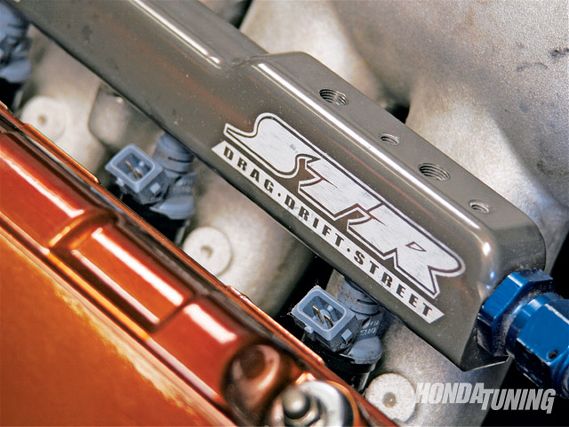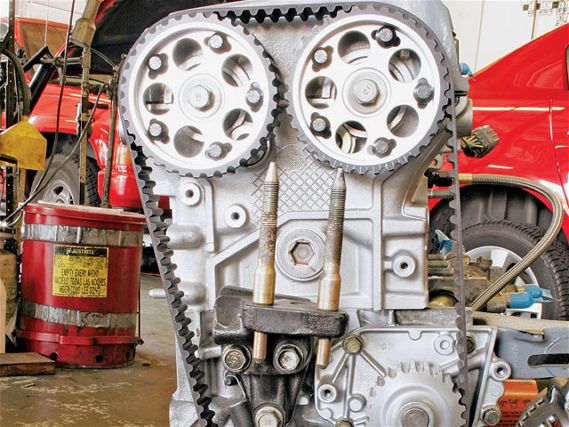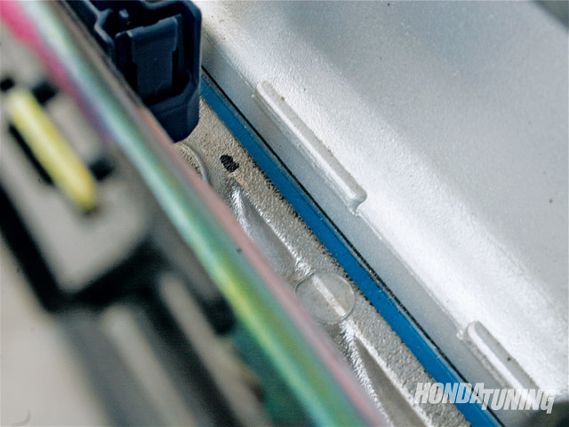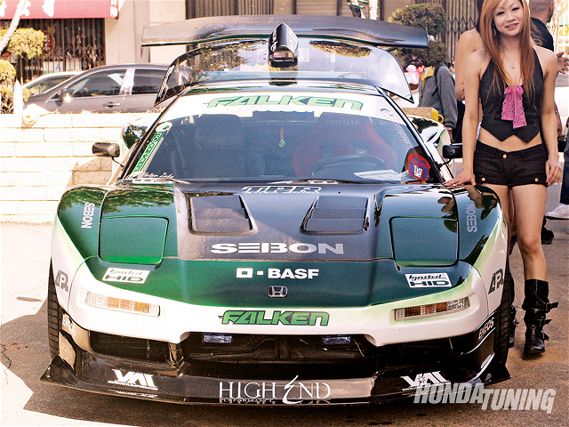 | Exhaust Notes - December 2008
| Exhaust Notes - December 2008
Fuel Rail Science
Are all fuel rails created equal? Fuel consumption and matching it correctly with the air intake has always been something that has plagued my mind. Are fuel rails simply another engine dress-up modification, intended as something cool-looking to hold the injectors in place, or do different fuel rails suit different applications better than others? What would be the best fuel rail for my K20A3 with an AEM cold-air intake?
Dan Creegan, Flushing, New York
We're sorry that fuel rails have plagued your mind for so long, hopefully we can help. High-horsepower engines that consume a lot of fuel will benefit more from a high-volume fuel rail than, say, a bone-stock B16A would. But there's a lot more to it than simply bolting on the rail. You've got to consider the fuel pump, lines, and filter, and injectors too. Increasing the capacity that the rail can hold without doing the same to the filter and lines will help very little. And unless you have fuel injectors that are capable of doing something with all of that extra volume, or a pump that can push it, you're really not getting much more than a shiny chunk of aluminum under your hood. That's not entirely a bad thing though; most aftermarket fuel rails feature NPT or AN ports, which makes external fuel regulators easier to adapt and can often solve tricky engine swap dilemmas. Unless you're pushing some serious power out of your K20A3 though, don't expect any performance gains from one brand to the next, in fact, don't expect any performance gains over your stock one.
 | Exhaust Notes - December 2008
| Exhaust Notes - December 2008
All-Motor B
I have a '97 Acura Integra RS. Right now it has the B18B1 engine in it. I'm looking into swapping my head for a B16A, GSR or Type R one. I know the cheapest way would be the B16A but what would I add to get my engine to 220 hp? On my list of things to add is Crower Stage 2 cams, a Hondata S300, a Blox intake manifold, a Megan Racing 4-2-1 header, and 330cc/min fuel injectors. I honestly think that with tuning I could hit 220 hp but would that be to the wheels? Also, I want to make it stick. What is the best LSD for an Integra tranny?
Patrick U., USS Dubuque LPD-8
The main difference between the B16A and the Type R cylinder heads is the hand porting that Honda applied to the Type R's. Honda didn't hog out the ports though, but rather massaged key areas, like the critical bend where air transitions from the ports past the valves. Of course, the Type R head also has a more aggressive valvetrain with higher lift, longer duration camshafts, but you don't care about that since you're talking about the Crowers. The GSR head isn't that much different and will actually yield a slightly higher compression ratio because of its smaller combustion chambers, so choose carefully because, depending on what pistons you're using, you may need that extra compression. You're on the right track as far as bolt-ons go. However, you might want to consider a header that's more specific to your application, like one from HyTech Exhaust or Bisimoto Engineering. Headers like these are based upon years of R&D and dyno science. Don't skimp here; you could have the most sophisticated top end and valvetrain around, but if you can't evacuate what's being burned efficiently, then you're just wasting your time. Oh, and as far as LSDs go, stick with a reputable brand like Cusco, Quaife, or Kaaz and you'll be fine. Proceed with the eBay knock-offs with caution.
 | Exhaust Notes - December 2008
| Exhaust Notes - December 2008
CTR Pulley Swap: Should I?
I recently bought an OEM Honda CTR crankshaft pulley for my JDM B18C engine and I would like to know if this part is okay for a stock, daily driver. The reason I ask this question is because there is so much controversy and hearsay surrounding this pulley. I was under the impression that a part made by Honda for a Honda engine was going to be 100-percent safe to use, but there are many claims against this. I like the fact that it weighs only 1.8 pounds and has no power steering or A/C provisions, but I also don't want a shattered oil pump gear as so many people claim will happen when using this pulley. What is the best thing to do? Thanks for helping me out and keep it coming!
Jonny Stack, Victoria, British Columbia
Honda's Civic Type R crankshaft pulley doesn't have the rubber damping material built into it like most other Honda pullies do. The damping material helps absorb harmonic vibrations caused by rotating assemblies that aren't perfectly balanced. When there's nothing to damp the vibrations, the oil pump gears typically suffer first. This isn't much of a problem when considering the CTR or ITR engines, which are just about the closest to zero-balanced engines you'll find from any OEM, which means harmonic vibrations are minimal. In fact, most Honda VTEC engines, even the non-Type R ones, are extremely well balanced, which means bolting on a CTR pulley-assuming everything else is okay with the engine-isn't a problem. Non-VTEC Integra and CRV engine blocks are a different story though and are not as meticulously balanced and assembled as the higher-revving VTEC ones. We're not knocking the non-VTEC engines though-they're still more reliable powerplants than most other OEMs put out, but they aren't the best candidates for the CTR pulley swap until they've been torn down, rebuilt, and properly balanced.
 | Exhaust Notes - December 2008
| Exhaust Notes - December 2008
An Intake Leak Or What?
I have an '01 Integra GSR and I just installed a Skunk2 Pro Series intake manifold, complemented with a Hondata heatshield gasket, and a Skunk2 70mm throttle body. After the installation was complete, and ever since, I have had an awkwardly high idle. Instead of the regular 900-ish rpm idle where it used to be, now it idles between 1,500 and 1,600 rpm. And when the car is rolling and I throw the clutch in, it goes to 2,500 rpm until I come to a stop where it drops down to 1,500 rpm. I checked to make sure that I have no vacuum leaks and everything is sealed up. I have asked a local garage and they said it could be the idle air control valve has seized up but I want to be sure of what could be causing this before I go spending money on parts I don't need. Thanks for the help.
Jake, Rochester, New Hampshire
The chances of the idle air control valve (IAC) deciding to seize up on you the day you installed your manifold and heatshield gasket are pretty slim. Sure, IACs can fail, but it's unlikely. First, check that you didn't accidentally loosen one of the wires when unplugging the IAC connector. Of course, if they were loose, your ECU would throw a check engine light. If this isn't the case, you probably need to hunt for a possible intake leak again. Grab a bottle of spray lubricant-like WD-40-or carburetor cleaner, and spray it toward any area where you suspect a leak. If the idle changes or the engine starts to run funny, you've just found your leak. Be sure to remove any remnants of old gasket material from the head and manifold and torque the manifold nuts evenly if you're going to try another gasket.
Big Brake Q&A
I have a '97 Integra LS with a B18B1. My question pertains to brakes. I want to know if NSX brake calipers would work or not, and if so, what would be needed for the brake conversion to work. Also, where is the best place to buy them because I've not come across any NSXs in the junkyards. Any help would be great.
John Pikett, Butler, Kentucky
Well, finding an NSX in a junkyard with parts left on it that you'll care about is next to impossible, so forget about that right now. You've still got some options though so don't panic. The process is similar for lots of cars, including the '99-'00 Civic Si and any other Civic with Integra front knuckles, so pay attention. Anyways, you can use the NSX calipers, but it'll require a pair of 11-inch rotors to work. The problem is that most 11-inch Honda rotors aren't offered in a 4x100 bolt pattern, which means you'll need to have a set redrilled. '93-'96 Prelude VTEC, 4x114.3 ones (11.1-inch) are your best bet since their centerbores are the same as the Integra's (64mm). You'll have to hunt online for NSX calipers though or you could always try the dealership or a remanufactured, OEM parts supplier. Once you get your calipers, you'll need to grind the inside of the caliper brackets to make everything fit properly, otherwise your rotors will never actually spin. If you have trouble finding a good set of NSX calipers, you might try looking for Accord V-6, Legend, or Integra Type R ones - they're bigger than what you've got and will also work with the 11.1-inch Prelude VTEC rotors. Only difference is they're all a bit heavier than the NSX ones and don't have the NSX's neat cooling vanes either.
B-Something
I already know what's involved in building an LS-VTEC, but for more reliability and a lower cost I'm thinking about getting a B16A. All I hear from everyone though is how torqueless the B16A is, but I've seen somewhere that the B17A is the same engine, just with a different crank. If this is true, would it be possible to just swap an OEM B17A crank, ITR or GSR pistons, and some GSR cams without a problem so that I could get a bit more horsepower and torque, or am I better off going a different route, like LS-VTEC? Both would be built to the same specs except for the differences in blocks: B18A/B with a VTEC conversion or the standard B16A build. They'd include ARP head studs and rod bolts, VTEC oil and water pumps, Toda or GReddy timing belts, ITR or GSR valvetrain, OEM bearings and rings, and an OEM headgasket. All I'm looking for is a fast and reliable daily driver with about 150-170 whp. Currently, I have a Y8 swap in a '94 hatch that I don't want to dump money into because I don't trust it on boost and I'd much rather go naturally aspirated B-series. People have said to stick with the Y8 and build it for boost or natural aspiration, but I feel I may have better results going B-series because it would be more cost effective than a D-series build. Thanks in advance and great mag; keep up the good work and hopefully I can make it into Grassroots or a possible feature. I'd include a few pics but cell phone pics won't look good in the magazine.
Steven, whereabouts unknown
Yes, thank you for not sending the cell phone pics. Despite how many people still send them in, we can't use them. Anyways, don't forget about the B17A1 rods; you'd need those too if you're going to swap the crank in, but why bother? It's a lot of trouble to go to for such a small amount of displacement, not to mention the fact that it really won't be any different than if you just started with a complete B17A1. If you're going to go to the trouble to open up a bottom end and swap heads, you might as well build an LS-VTEC. You said yourself that you know what to do to build a reliable one. You can stick with the ITR pistons and GSR camshafts and, with a few bolt-ons, you should have no problem hitting the 170-whp mark. Have you considered just going with something like a JDM-spec B18C though? These produce upwards of 150 whp in stock trim, which means you could hit your 170-whp mark with bolt-on efforts.
Got questions, comments, love, or hate?
Send your letters to:
[email protected]
Or snail mail to:
Honda Tuning
2400 E. Katella Avenue, Suite 1100Anaheim, CA 92806
